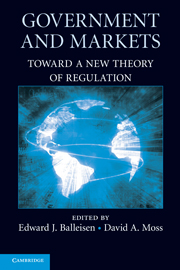Book contents
- Frontmatter
- Contents
- Acknowledgments
- Contributors
- Introduction
- SECTION I BEYOND MARKET FAILURE
- SECTION II BEYOND THE ECONOMIC THEORY OF POLITICS
- SECTION III BEYOND COMMAND AND CONTROL
- 10 What Opportunity Is Knocking? Regulating Corporate Governance in the United States
- 11 Taxation as a Regulatory Tool: Lessons from Environmental Taxes in Europe
- 12 Redesigning Regulation: A Case Study from the Consumer Credit Market
- 13 Origins and Regulatory Consequences of the Subprime Crisis
- 14 The Prospects for Effective Coregulation in the United States: A Historian's View from the Early Twenty-First Century
- 15 Deregulation Theories in a Litigious Society: American Antitrust and Tort
- 16 Markets in the Shadow of the State: An Appraisal of Deregulation and Implications for Future Research
- Conclusion
- Index
- References
11 - Taxation as a Regulatory Tool: Lessons from Environmental Taxes in Europe
Published online by Cambridge University Press: 20 January 2010
- Frontmatter
- Contents
- Acknowledgments
- Contributors
- Introduction
- SECTION I BEYOND MARKET FAILURE
- SECTION II BEYOND THE ECONOMIC THEORY OF POLITICS
- SECTION III BEYOND COMMAND AND CONTROL
- 10 What Opportunity Is Knocking? Regulating Corporate Governance in the United States
- 11 Taxation as a Regulatory Tool: Lessons from Environmental Taxes in Europe
- 12 Redesigning Regulation: A Case Study from the Consumer Credit Market
- 13 Origins and Regulatory Consequences of the Subprime Crisis
- 14 The Prospects for Effective Coregulation in the United States: A Historian's View from the Early Twenty-First Century
- 15 Deregulation Theories in a Litigious Society: American Antitrust and Tort
- 16 Markets in the Shadow of the State: An Appraisal of Deregulation and Implications for Future Research
- Conclusion
- Index
- References
Summary
Introduction
Governments have always used taxation to regulate their citizens' behavior, from the Babylonian divorce tax of 2350 B.C. (Burg, 2004) to the latest child tax credits. The regulatory tax receiving the most attention from scholars, activists, and policymakers these days is a tax on pollution. Ever since A.C. Pigou argued that some market exchanges produce externalities that are not captured in the exchange itself, pollution has been the classic example of a market externality, and recently a carbon tax has been proposed as an alternative to the more popular cap-and-trade method of controlling pollution. Cap and trade, critics argue, causes excessive price volatility, cannot adjust for swings in the business cycle, and too easily captured by special interests. Taxation, on the other hand, is more flexible and less bureaucratic. Environmental taxes seem to be a benefit for all: They would reduce the negative outcome of bad pollution; they would generate revenue that could be used to reduce other taxes (a “double dividend”), or to offset the regressivity of the tax; and they would contribute to energy independence. Although at the national level American policymakers seem more interested in cap-and-trade, interest in green taxes is intense in many countries, and several American states have adopted them.
But do green taxes work? Environmental taxes have been in place in several countries since the early 1990s, but the experience is mixed.
- Type
- Chapter
- Information
- Government and MarketsToward a New Theory of Regulation, pp. 363 - 390Publisher: Cambridge University PressPrint publication year: 2009
References
- 8
- Cited by



